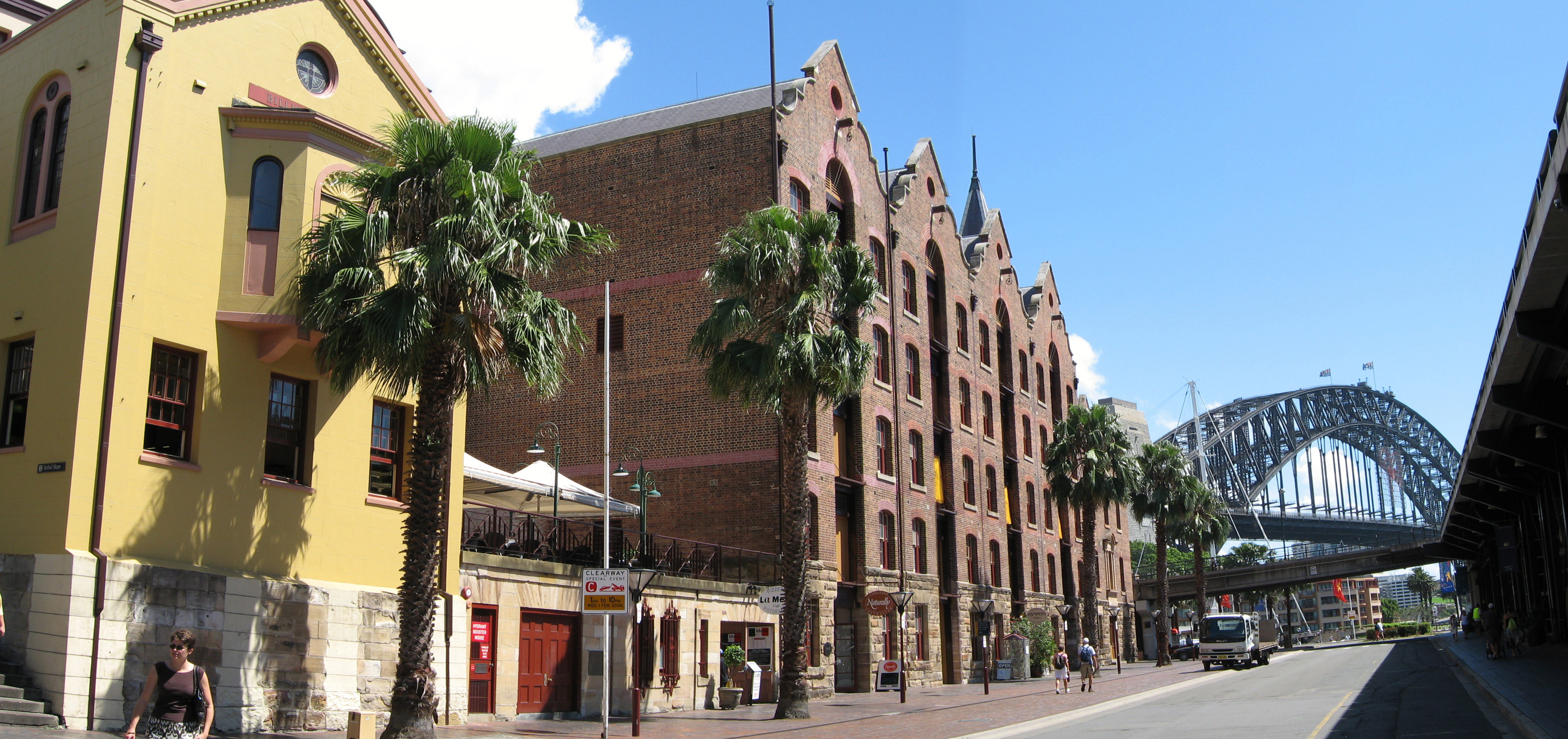- The Rocks, New South Wales
Infobox Australian Place | type = suburb
name = The Rocks
city = Sydney
state = nsw

caption = Circular Quay West
lga = City of Sydney
parish = St. Philip
postcode = 2000
est =
pop =
area =
propval =
stategov = Sydney [Cite web |url=http://www.elections.nsw.gov.au/state_government_elections/electoral_districts/all_districts_/sydney |title=Sydney |publisher=Electoral Commission of NSW]
fedgov = Sydney [Cite web |url=http://www.aec.gov.au/_content/who/profiles/s/sydney.htm |title=Sydney |publisher=Australian Electoral Commission]
near-nw = Dawes Point
near-n = Dawes Point
near-ne = "Sydney Cove"
near-w = Millers Point
near-e = "Sydney Cove"
near-sw = Millers Point
near-s =Sydney CBD
near-se =Sydney CBD
dist1 = 1
location1= Sydney CBDThe Rocks is an inner-city
suburb ,tourist precinct and historic area ofSydney , in the state ofNew South Wales ,Australia . It is located on the southern shore ofSydney Harbour , immediately north-west of theSydney central business district and is part of the local government area of theCity of Sydney . The postcode is 2000.The Rocks area borders on the Bradfield Highway, leading to the
Sydney Harbour Bridge , with the suburbs of Dawes Point and Millers Point, to the west. It is immediately adjacent toCircular Quay onSydney Cove , the site of Australia's first European settlement in 1788.History
The Rocks became established shortly after the colony's formation in 1788. The original buildings were made mostly of local sandstone, from which the area derives its name. From the earliest history of the settlement, the area had a reputation as a
slum , often frequented by visiting sailors and prostitutes. During the late 1800s, the area was dominated by a gang known as theRocks Push . It maintained this rough reputation until approximately the 1970s.By the early twentieth century, many of the area's historic buildings were in serious decay. In 1900,
bubonic plague broke out, and the state government resumed areas around The Rocks andDarling Harbour , with the intention of demolishing them and rebuilding them. Part of the area was demolished, but redevelopment plans were stalled by the outbreak ofWorld War I . During the 1920s, several hundred buildings were demolished during the construction of theSydney Harbour Bridge . However, the outbreak ofWorld War II once again stalled many of the redevelopment plans, and it was not until the 1960s that serious attempts to demolish much of the area were revived.In 1968, the state government gave control of The Rocks to the Sydney Cove Redevelopment Authority, with the intention of demolishing all the original buildings, re-developing them as high-density residential dwellings. In February 1971, a group of local residents formed the Rocks Residents Group to oppose the plans. They felt that the new dwellings would result in increased rents, which would force out the traditional residents of the area. The residents' group requested a
Green ban from theBuilder's Labourers Federation , who had become increasingly active in preventing controversial developments over the previous four years.By 1973, the union had imposed the ban, and after discussions with the Sydney Cove Redevelopment Authority, a 'People's Plan' was developed. By October 1973, it appeared that the redevelopment would proceed as originally planned, using non-union labor. For two weeks, demonstrations by local residents and unionists followed, with numerous arrests being made. Liberal Premier
Robert Askin was in the midst of an election campaign, and used the protests as a means of conveying his law and order message to voters. However, the green ban stayed in place until 1975, when the state union leadership was overthrown, and was ultimately successful, as can be seen in the buildings that survive today. Instead of demolishing The Rocks, renovations transformed the area into a commercial and tourist precinct.Today the Rocks is a partly gentrified area, but still contains a significant proportion of Housing Commission properties, and there is still a significant problem of urban poverty and street crime in this district. As housing stock becomes dilapidated, government policy is to sell the now extremely valuable public housing units to private owners, in the expectation that they will restore the properties.
Culture
The close proximity to Circular Quay and the views of the iconic Harbour Bridge, as well as the historic nature of many of the buildings, mean that the Rocks is very popular with tourists. It features a variety of
souvenir andcraft shops, and many themed and historicpub s. The Rocks Market operates each weekend, with around 100 stalls. There are numerous historic walks through the area, visiting historical buildings such asCadman's Cottage andSydney Observatory , and the Dawes Point Battery, which was the first fortified position inNew South Wales .Two separate pubs in The Rocks claim to be Sydney's oldest surviving pubs, the Lord Nelson and the Fortune of War. Others in the area include the Orient, the Mercantile, the Palisade and the Hero of Waterloo.
A passenger boat terminal and the
Museum of Contemporary Art, Sydney is also situated beside the Rocks area. The precinct can also be accessed by rail, as it is within walking distance of Circular Quay station.Popular Culture
Written by
Ruth Park , the book and film "Playing Beatie Bow " featuredtime-travel back to The Rocks during the late 1800s.Gallery
References
External links
Wikimedia Foundation. 2010.
